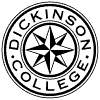
Pictured above from left to right are: Morgan, Waugh, Mrs.
Waugh, and Spahr
Heather Reardon
James Henry Morgan took over as president of Dickinson College when President Eugene Allen Noble resigned from the position in 1914. Morgan took over at a time when situations were so bad, that the college questioned whether or not to remain opened. At the time, no one had any idea of the enormous dedication Morgan would have to the college. "President Morgan would leave town only on College business, generally recruiting of students, staying on the job until, after fourteen years, a breakdown brought him to the hospital".1 During his prosperous tenure, Morgan made many improvements to the college, including doubling the enrollment of the college. In 1928, at the age of seventy-two, Morgan decided to retire.
The Board of Trustees met on August 1, 1928 and elected College Dean Mervin Grant Filler to take Morgan's place. Filler was the first layman to serve as president of Dickinson College. His first act as president was to appoint Montgomery Porter Sellers to the position of Dean of the College. The two men had been in the same graduating class in 1893. According to Ben James, a student at the time, Filler was known as an excellent teacher, but when he assumed the presidency in 1929, students had a feeling that he was not well. He was "well-esteemed, well-liked, but in the various events and so on he did not have a strong presence".2
The students' feelings turned out to be true, as Filler died due to complications from influenza on March 28, 1931. He had served less than two years as president. However, during his brief period of leadership, Filler did manage to finish the new gymnasium, renovate Conway Hall into a residence hall, and obtain a Carnegie Corporation grant for books for the library.3 Students mourned Filler's death as they felt he was an excellent teacher. A campus visitor was quoted regarding Filler, "You took a perfectly good professor and made him into a poor president".4 Following Filler's death, Boyd Lee Spahr, a member of the Board of Trustees, offered Morgan the presidency temporarily until a new president was found. Morgan accepted, and after spending two years in retirement, he came back to work. As compensation, Morgan was given a four-year term on the Board of Trustees.
The Board of Trustees began a search for a new president. A trustee, Bishop William Fraser McDowell, suggested Karl Tinsley Waugh, a graduate of Ohio Wesleyan.5 The Board elected Waugh unanimously on October 10, 1931, however Waugh did not begin his term until January 1, 1932. Waugh was neither a clergyman nor an alumnus of Dickinson College. Ben James commented on Waugh saying that from the beginning, there seemed to be a rejection of Waugh by the facutly. Waugh assumed the position of president and began implementing new plans immediately, which upset both faculty and also trustees.6 For instance, at a faculty meeting in 1932, Waugh adopted new regulations regarding student standing. Also, Waugh came up with a plan to modernize the curriculum.7 Waugh also made reforms in the athletic program and the absence system. His system for absence based the number of absences allowed per year on the grade the student had earned in the previous semester.8 In 1933, the Dickinson Alumnus included an article proclaiming the fact that over 90% of all male students were able to participate in sports at Dickinson due to the the athletic provisions.9 In addition, during Waugh's tenure, the purchase of Mooreland was made. This was a twelve acre estate near High and College Streets. This land served was used for various purposes, including athletic events and also gardens maintained by the Biology department.10
Morgan kept close tabs on Waugh during his tenure and he began to get upset at all the reforms Waugh was making. He used his position as a trustee to "launch a campaign of apalling vilification" against Waugh.11 In 1933, a committee was appointed by the Board of Trustees to look at the affairs of the college. The committee came to the decision that the administration needed to be changed.12 Waugh was notified of the committee's decision and chose to resign, feeling that the Board was not in agreement with his type of leadership. He resigned on June 24, 1933 after having been in leadership for only a year and a half. However, during this time, the college reached the highest enrollment in its history and student relations were greatly improved due to Waugh's reforms. Waugh's resignation came as a shock and a disappointment to many of the students.13
Morgan was made president for the third time following Waugh's resignation. At seventy-two, Morgan retired, only to be made acting president at the age of seventy-four, and then again at age seventy-six. During this period, Morgan made many efforts to reverse many of Waugh's plans and reforms. Morgan served as president until Dr. Fred Pierce Corson was elected as the twentieth president of the college in June of 1934.

Pictured above from left to right are: Morgan, Waugh, Mrs.
Waugh, and Spahr
Heather Reardon
 |
|
Dickinson 1934 is a project of Prof. Osborne's History 204 Class, Fall Semester 2000. |
1.
Sellers, Charles Coleman. Dickinson College: A History.
Middletown: Wesleyan
University Press, 1973.
2.
Interview with Ben James. Interviewed by Professor John Osborne.
June 7, 2000.
3. Sellers, 341.
4. Sellers, 341.
5. Sellers, 342.
6. James.
7. Sellers, 345.
8.
"Morgan Gives Absence Plan for Students." The Dickinsonian
16 Nov. 1933: 1.
9.
"Nearly Every Student Participates in Sports." The Dickinson Alumnus
Feb.
1933: 8.
10. Morgan,
James Henry. Dickinson College 1783-1933. Carlisle:
Dickinson
College, 1933. (391-392).
11. Sellers, 345.
12. "Morgan
Again Assumes Head of Dickinson." The Dickinsonian 28
Sept. 1933:
8.
13. "Morgan Again
Assumes Head of Dickinson." The Dickinsonian 28 Sept.
1933:
8.